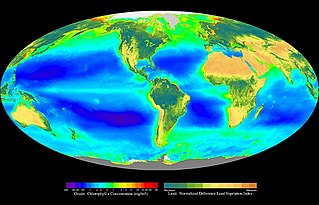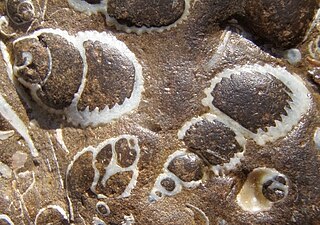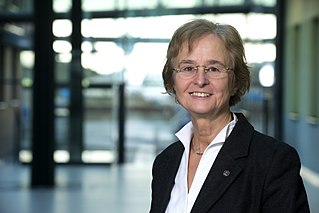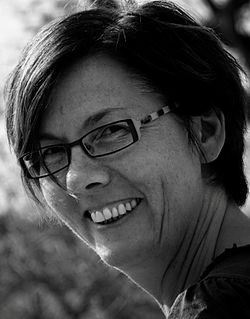
Methane clathrate (CH4·5.75H2O) or (4CH4·23H2O), also called methane hydrate, hydromethane, methane ice, fire ice, natural gas hydrate, or gas hydrate, is a solid clathrate compound (more specifically, a clathrate hydrate) in which a large amount of methane is trapped within a crystal structure of water, forming a solid similar to ice. Originally thought to occur only in the outer regions of the Solar System, where temperatures are low and water ice is common, significant deposits of methane clathrate have been found under sediments on the ocean floors of the Earth.

In ecology, primary production is the synthesis of organic compounds from atmospheric or aqueous carbon dioxide. It principally occurs through the process of photosynthesis, which uses light as its source of energy, but it also occurs through chemosynthesis, which uses the oxidation or reduction of inorganic chemical compounds as its source of energy. Almost all life on Earth relies directly or indirectly on primary production. The organisms responsible for primary production are known as primary producers or autotrophs, and form the base of the food chain. In terrestrial ecoregions, these are mainly plants, while in aquatic ecoregions algae predominate in this role. Ecologists distinguish primary production as either net or gross, the former accounting for losses to processes such as cellular respiration, the latter not.

The biological pump, in its simplest form, is the ocean's biologically driven sequestration of carbon from the atmosphere to the ocean interior and seafloor sediments. It is the part of the oceanic carbon cycle responsible for the cycling of organic matter formed mainly by phytoplankton during photosynthesis (soft-tissue pump), as well as the cycling of calcium carbonate (CaCO3) formed into shells by certain organisms such as plankton and mollusks (carbonate pump).

A continental shelf is a portion of a continent that is submerged under an area of relatively shallow water known as a shelf sea. Much of these shelves has been exposed during glacial periods and interglacial periods. The shelf surrounding an island is known as an insular shelf.
The mesopelagiczone, also known as the middle pelagic or twilight zone, is the part of the pelagic zone that lies between the photic epipelagic and the aphotic bathypelagic zones. It is defined by light, and begins at the depth where only 1% of incident light reaches and ends where there is no light; the depths of this zone are between approximately 200 to 1000 meters below the ocean surface. It hosts a diverse biological community that includes bristlemouths, blobfish, bioluminescent jellyfish, giant squid, and a myriad of other unique organisms adapted to live in a low-light environment. It has long captivated the imagination of scientists, artists and writers; deep sea creatures are prominent in popular culture, particularly as horror movie villains.

Organic-rich sedimentary rocks are a specific type of sedimentary rock that contains significant amounts (>3%) of organic carbon. The most common types include coal, lignite, oil shale, or black shale. The organic material may be disseminated throughout the rock giving it a uniform dark color, and/or it may be present as discrete occurrences of tar, bitumen, asphalt, petroleum, coal or carbonaceous material. Organic-rich sedimentary rocks may act as source rocks which generate hydrocarbons that accumulate in other sedimentary "reservoir" rocks. Potential source rocks are any type of sedimentary rock that the ability to dispel available carbon from within it. Good reservoir rocks are any sedimentary rock that has high pore-space availability. This allows the hydrocarbons to accumulate within the rock and be stored for long periods of time. Highly permeable reservoir rocks are also of interest to industry professionals, as they allow for the easy extraction of the hydrocarbons within. The hydrocarbon reservoir system is not complete however without a "cap rock". Cap rocks are rock units which have very low porosity and permeability, which trap the hydrocarbons within the units below as they try to migrate upwards.
Paleoceanography is the study of the history of the oceans in the geologic past with regard to circulation, chemistry, biology, geology and patterns of sedimentation and biological productivity. Paleoceanographic studies using environment models and different proxies enable the scientific community to assess the role of the oceanic processes in the global climate by the re-construction of past climate at various intervals. Paleoceanographic research is also intimately tied to paleoclimatology.

The Leibniz Institute for Baltic Sea Research is a research institution located in Warnemünde (Rostock), Germany.

Siliceous ooze is a type of biogenic pelagic sediment located on the deep ocean floor. Siliceous oozes are the least common of the deep sea sediments, and make up approximately 15% of the ocean floor. Oozes are defined as sediments which contain at least 30% skeletal remains of pelagic microorganisms. Siliceous oozes are largely composed of the silica based skeletons of microscopic marine organisms such as diatoms and radiolarians. Other components of siliceous oozes near continental margins may include terrestrially derived silica particles and sponge spicules. Siliceous oozes are composed of skeletons made from opal silica Si(O2), as opposed to calcareous oozes, which are made from skeletons of calcium carbonate organisms (i.e. coccolithophores). Silica (Si) is a bioessential element and is efficiently recycled in the marine environment through the silica cycle. Distance from land masses, water depth and ocean fertility are all factors that affect the opal silica content in seawater and the presence of siliceous oozes.

Karin Lochte is a German oceanographer, researcher, and climate change specialist. In 2007, she became director of the Alfred Wegener Institute in Bremerhaven as well as chairman of the management committee of Jacobs University Bremen.

Hotspot Ecosystem Research and Man's Impact On European Seas (HERMIONE) is an international multidisciplinary project, started in April 2009, that studies deep-sea ecosystems. HERMIONE scientists study the distribution of hotspot ecosystems, how they function and how they interconnect, partially in the context of how these ecosystems are being affected by climate change and impacted by humans through overfishing, resource extraction, seabed installations and pollution. Major aims of the project are to understand how humans are affecting the deep-sea environment and to provide policy makers with accurate scientific information, enabling effective management strategies to protect deep sea ecosystems. The HERMIONE project is funded by the European Commission's Seventh Framework Programme, and is the successor to the HERMES project, which concluded in March 2009.

Antje Boetius is a German marine biologist presently serving as professor of geomicrobiology at the Max Planck Institute for Marine Microbiology, University of Bremen. She received the Gottfried Wilhelm Leibniz Prize, with 2.5 million euros in funding, in March 2009 for her study of sea bed microorganisms that affect the global climate. She was the first person to describe anaerobic oxidation of methane, and believes the Earth's earliest life forms may have subsisted on methane in the absence of molecular oxygen. She has also suggested such life forms may be able to reduce the rate of climate change in future. She is one the laureate of the 2018 Environment Prize
The Leibniz-Zentrum für Marine Tropenforschung (ZMT) in Bremen, Germany is the only scientific institute in Germany that exclusively investigates tropical and subtropical coastal ecosystems and their significance for nature and humans in an interdisciplinary approach. The mission of ZMT is to provide a scientific basis for the protection and sustainable use of tropical coastal ecosystems by conducting research, capacity development and consulting activities in close cooperation with national and international partners in the tropics. Since its launch in 1991, ZMT has also developed a huge network of research and political partners within the tropics and worldwide, including more than 800 alumni. The institute offers a broad range of research infrastructure, including its own scientific diving centre and laboratories such as the Marine Experimental Ecology Facility (MAREE). ZMT also hosts the Future Earth Coasts (FEC) office, a global network of experts investigating the drivers of global change in coastal zones.

The GEOMAR - Helmholtz Centre for Ocean Research Kiel (GEOMAR), former Leibniz Institute of Marine Sciences, is a research institute in Kiel, Germany. It was formed in 2004 by merging the Institute for Marine Science with the Research Center for Marine Geosciences (GEOMAR) and is co-funded by both federal and provincial governments. It was a member of the Leibniz Association till 2012 and is coordinator of the FishBase Consortium. Since 2012 it is member of the Helmholtz Association and named GEOMAR - Helmholtz Centre for Ocean Research Kiel. The institute operates worldwide in all ocean basins, specialising in climate dynamics, marine ecology and biogeochemistry, and ocean floor dynamics and circulation. GEOMAR offers degree courses in affiliation with the University of Kiel, and operates the Kiel Aquarium and the Lithothek, a repository for split sediment core samples.
Roger Everett Summons is the Schlumberger Professor of Geobiology at the Massachusetts Institute of Technology and Professor of Geobiology in the Department of Earth, Atmospheric and Planetary Sciences.
The Deep Carbon Observatory (DCO) is a global research program designed to transform understanding of carbon's role in Earth. DCO is a community of scientists, including biologists, physicists, geoscientists and chemists, whose work crosses several traditional disciplinary lines to develop the new, integrative field of deep carbon science. To complement this research, the DCO's infrastructure includes public engagement and education, online and offline community support, innovative data management, and novel instrumentation development.
Syed Wajih Ahmad Naqvi is an Indian marine scientist and the former director of the National Institute of Oceanography. His work has concentrated in oceanic water chemistry, biogeochemistry, and chemical interrelations with living organisms. He has also performed research on freshwater ecosystems. He was the Chief Indian Scientist of LOHAFEX, an Ocean Iron Fertilization experiment jointly planned by the Council of Scientific Industrial Research (CSIR), India, and Helmholtz Foundation, Germany.

Bettina Meyer is a German Antarctic researcher, best known for her work on the ecology and physiology of invertebrates in the pelagic zone. She is the head of the ecophysiology of pelagic key species working group at the Alfred Wegener Institute for Polar and Marine Research (AWI).
The Geochemical Ocean Sections Study (GEOSECS) was a global survey of the three-dimensional distributions of chemical, isotopic, and radiochemical tracers in the ocean. A key objective was to investigate the deep thermohaline circulation of the ocean, using chemical tracers, including radiotracers, to establish the pathways taken by this.
The Institut für Meereskunde in Kiel, Germany, existed from April 1, 1937 to January 1, 2004. It was an essential element of the long history of marine sciences in Kiel. This history started with the work of Samuel Reyher published in 1697 and is today continued within the GEOMAR Helmholtz Centre for Ocean Research Kiel.